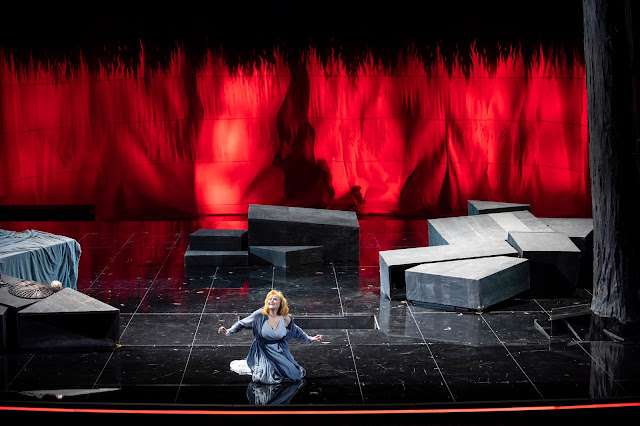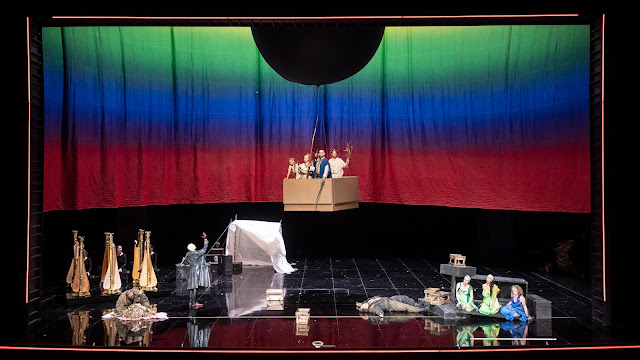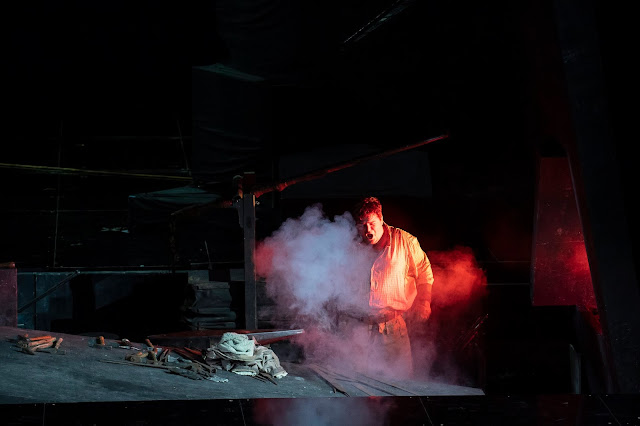 |
| Gotterdammerung - Grand Théâtre de Genève (Photo Carole Parodi) |
The revival of Dieter Dorn’s Ring cycle proved a popular choice for the reopening of the Grand Théâtre de Genève following a £50 million refit
Our roving correspondent Tony Cooper experiences Wagner’s Der Ring des Nibelungen at the Grand Théâtre de Genève directed by Dieter Dorn with Michelle Breedt, Agneta Eichenholz, Tom Fox, Stephan Genz, Will Hartmann, Michaela Kaune, Petra Lang, Wiebke Lehmkuhl, Jeremy Milner, Stephan Rügamer, Taras Shtonda, Mark Stone, Alexey Tikhomirov, Tómas Tómasson, and Michael Weinius, and conductor Georg Fritzsch.
First presented in the 2013-14 season, this Ring cycle (lovingly revived to reopen the grandly-refurbished Grand Théâtre de Genève) was created by the legendary Leipzig-born director, Dieter Dorn, a former director of the Kammerspiele and Staatsschauspiel in Munich and an emblematic and well-loved theatrical personality in Geneva.
Designed by Jacques-Elisée Goss, the Grand Théâtre (built during the period from 1875 to 1879) replaced the Théâtre des Bastions but during a rehearsal of Die Walküre on 1st May 1951, the pyrotechnical effects employed for Brünnhilde’s Ring of Fire got out of hand and fire ravaged the building in a savage and brutal way leaving only the foyer space intact. It took 11 years to get the theatre up and running again and it duly reopened on 10th December 1962.
Generally, opera-houses have lavishly-furnished interiors adorned with beautifully-designed ceilings such as Marc Chagall’s splendid offering at Opéra Garnier in Paris. It’s a joy to behold but so, too, is the ceiling of the Grand Théâtre. Appropriately entitled ‘Alto’ it was created by Kraków-born artist, Jacek Stryjenski.
A glorious and inspiring piece of art, each element comprises a host of silver-leafed, copper-inlaid, brushed aluminium panels embedded with hundreds of minute glass-lights (made from Venetian glass from the island of Murano) representing The Milky Way. Romantically, I like to think that it caught the wandering eye of Wotan dreaming of his heavenly home! Mr Stryjenski (who died in his adopted home town of Geneva at the early age of 38) also designed much of the décor of the Geneva Puppet Theatre.
Before the commencement of a three-year restoration programme, costing in the region of £50 million, the last production at the Grand Théâtre (December 2015) was Die Zauberflöte directed by Jürgen Rose who happens to be the set and costume designer for this Ring cycle. During their time in the wilderness, however, the Grand Théâtre decamped to the Opéra des Nations concert-hall sited next to the European headquarters of the United Nations.
Interestingly, this structure, built entirely of wood, was recycled from a temporary building used by La Comédie-Française in Paris when that well-loved theatre (widely considered to be the oldest active theatre in the world) underwent a major restoration programme. The city of Geneva acquired the disassembled pieces in the spring of 2014 and when it was rebuilt it was also enlarged and fitted out with red-velvet upholstered seats. Its next stopping-point is Beijing. Normally, it’s companies that tour!
The reopening of the Grand Théâtre (a wonderful neo-classically-designed building proudly sitting amidst Place Neuve and officially opened in 1879) coincides with the theatre’s 140th anniversary. Therefore, I cannot think of any better way to celebrate such an auspicious occasion as this than by a performance of Wagner’s Ring cycle. Amazingly, the house pushed the boat out and incorporated three cycles in their opening season. The second cycle commences on 5th March (Shrove Tuesday) and the third a week later - Tuesday (12th March). It’s worth every penny!
However, the scenario of the Ring (mainly sourced from Norse sagas and the German epic poem The Nibelungenlied) is a mighty, powerful and adventurous work of great substance and the scale of it is firmly established by those haunting opening bars of Das Rhinegold) - termed a ‘Vorabend’ (Preliminary Evening) by Wagner whilst he coined the three main works of the cycle a ‘Bühnenfestspiel’ (Stage Festival Play) - comprising a low-elongated E-flat major chord lasting just over 130 bars.
At first the notes of the chord are firmly held before gradually giving way to a set of broken chords and arpeggios conjuring up ripples of water and when the harps flood in making aggressive sound-like waves evoking the sunrise, it vividly captures and creates a broad and atmospheric canvas of the Rhine and the start of another day.
 |
| Das Rheingold - Grand Théâtre de Genève (Photo Carole Parodi) |
It sent shivers down my spine (it always does!) and the trio of Rhinemaidens - Woglinde (Polina Pastirchak), Wellgunde (Carine Séchaye) and Flosshilde (Ahlima Mhamdi) - portrayed their respective roles in loving harmony frolicking amongst the rocks teasing the dissatisfied and frustrated Nibelung dwarf, Alberich, to breaking-point with their girlish charms. But, of course, he soon gets the better of them when he runs off with the gold. The role of Alberich was so well interpreted and sung by American baritone, Tom Fox, who, incidentally, has enjoyed an active international career spanning five decades.
Overall, the casting was spot on. German-born soprano and Bayreuth regular, Petra Lang, proved a brilliant choice for the pivotal role of Brünnhilde acting youthful, energetic and full of beans in the early stages of the cycle as the role demands with her mood and persona changing considerably in the telling moments at the end while Swedish tenor, Michael Weinius, shone as Siegfried and Finnish tenor, Dan Karlström, was crafty and cunning to the core in the role of Mime. What a voice! So articulate and clear.
Russian bass Alexey Tikhomirov (Fasolt) harboured a deep rich voice as deep as the Rhine itself and Ukrainian bass Taras Shtonda (Fafner) proved an equal match. They found themselves in bullish mood as befitting their sinister characters singing with gusto and strength looking the part from head to toe while Romanian lyric soprano Ruxandra Donose (Fricka) and German contralto Wiebke Lehmkuhl (Erda) were simply divine not only in their singing but in their stagecraft as well.
For instance, in the second act of Die Walküre, Ms Donose illuminated the stage in her tête-à-tête with Wotan (Tómas Tómasson) - who was impeccable in this most demanding of roles which he sang with edgy nervousness and impatience - landing into him fair-and-square giving him a good piece of her mind over his extra-marital affairs while defending her sister Freia (Agneta Eichenholz - who also sang Gutrune in Götterdämmerung) from the wrath and intimidation of the Giants. Wotan’s side-kick, Loge, was well portrayed by Stephan Rügamerma sporting a red skullcap and matching shoes and the roles of Frei’s brothers - Donner (Stephan Genz) and Froh (Christoph Strehl) - perfectly fitted the bill.
 |
| Die Walküre - Grand Théâtre de Genève (Photo Carole Parodi) |
This production employed a host of Supernumeries ranging from Rhinemaidens on roller-blades to Nibelung characters crawling mercilessly about the stage while a ball of bright orange light represented the Rhine’s golden bounty and the trio of Norns (the roles so well sung by Wiebke Lehmkuhl, Roswitha Christina Müller and Karen Foster) were seen pushing the Rope of Destiny (represented by an over-sized ball) but in Götterdämmerung it appeared ripped to smithereens lying in tatters.
And to escape the unwanted attention of the Giants in Das Rhinegold - who were first seen in silhouette form thus making them look larger, sinister and more menacing - Freia locked herself in a box while Fricka was seen enjoying the golden bounty (trinkets not bars) and a rainbow curtain swept the entire width of the stage for the Gods’ entry in to Valhalla.
The scene in which Wotan and Loge venture to the underground city of Nibelheim conjured up a dark moment and a great feat of stage engineering, too, with hydraulic platforms moving slowly here, there and everywhere. Mesmerising! Alberich’s power, however, was short lived (world politicians ought to see a Ring production!) and he soon lost out after being tricked by his boastfulness of the magic properties of the Tarnhelm.
A simple staging for Hunding’s house in Die Walküre comprised just a half-dozen black panels with the World Ash Tree dominating the stage with Supers running wild hunting on horseback while Fricka arrived in her chariot powered by five rams and Siegmund and Sieglinde (Will Hartmann and Michaela Kaune) dramatically ended the first act in a highly-passionate embrace enjoying every minute of their brief encounter while Grane was seen as a marionette operated by two puppeteers who worked in an orderly and clockwork fashion.
 |
| Siegfried - Grand Théâtre de Genève (Photo Carole Parodi) |
The chemistry between Mime and Siegfried clicked well and a brief moment of tenderness surfaced between them when Mime explains to the boy about his mother. The forging of Nothung was quite a low-key affair with Siegfried tapping away at a red-neon-lit forge working a set of bellows to fuel the fire and fiddling about with odd smithy items to finish the job.
The forest scene in which Siegfried confronts Fafner was visually stunning with an extra-large, two-faced, rounded head of the dragon dominating the stage. It had a Harry Potter feel about it! The Woodbird was sung so eloquently by Mirella Hagen whose tender and calming voice was just the ticket for this role which she has sung on so many occasions to audience pleasure.
At the end of Siegfried, Petra Lang got right into the skin of Brünnhilde’s character reawakening on her burning rock and reaching out to her faithful steed, Grane. Looking radiant and full of promise sporting shoulder-length blonde hair and attired in a long-flowing Marian blue dress, she exclaims ‘Hail, Sun! Hail, Light! Hail, Radiant Day! which ultimately leads into the long duet that cements the love between her and her hero, Siegfried.
But their love and harmony was short-lived and when two ravens fly overhead (seen as aerialists) in the final scene of Götterdämmerung it witnesses the day of the twilight of the Gods. It delivered a great moment in the whole of the opera as Siegfried, regally at rest on his funeral pyre with Brünnhilde as loyal as ever by his side, are seen disappearing to the murky depths of the Rhine on a stage covered by an expansive translucent black cloth with Supers activating wave-like patterns. The trio of Rhinemaidens rise to the surface gleefully happy once more to be in possession of the ring which evaded the cunning efforts of Hagen portrayed so strongly by American bass, Jeremy Milner, who landed into Gunther (Mark Stone) to achieve his aims and ambitions while destroying his sister Gutrune (Agneta Eichenholz) in the process.
 |
| Gotterdammerung - Grand Théâtre de Genève (Photo Carole Parodi) |
So, too, goes for the Orchestre de la Suisse Romande who performed brilliantly under the baton of Georg Fritzsch squeezing every nuance out of Wagner’s majestic and mighty score especially in the big production numbers such as the Gods’ entry into Valhalla, Siegfried’s momentous Rhine journey and the Funeral March from Götterdämmerung. It was exciting stuff to say the least!
When Maestro Fritzsch took his bow, he looked absolutely delighted. And quite right, too! He knew that the orchestra delivered the goods and so did the audience who more than showed their appreciation by a rapturous curtain-call underlying that the work done in the pit is equal to the work done on stage. He deserved a good bow and likewise, too, for Alan Woodbridge, a former Trinity College Cambridge organ scholar and now chorus-master of the Grand Théâtre Opera Chorus. He drilled his charges well.
And talking of bows, Professor Tobias Richter, the Grand Théâtre’s general director (who actually began his professional career in 1972 at the Grand Théâtre as personal assistant to theatre director, Götz Friedrich) retires from his post at the end of the current season after a ten-year stint. Therefore, Professor Richter, it’s your turn to take a bow. Au revoir!
The whole trip to Geneva proved to be absolutely delightful. Here’s to the next time!
Director (Dieter Dorn)
Assistant director (Veronika Obermeier)
Set designer / costume designer (Jürgen Rose)
Lighting designer (Tobias Löffler)
Marionette creators (Susanne Forster and Stefan Fichert)
Dramaturg (Hans-Joachim Ruckhäberle)
Body expression (Heinz Wanitschek)
Video (Jana Schatz)
Orchestre de la Suisse Romande (Conductor: Georg Fritzsch)
Grand Théâtre Opera Chorus (Director: Alan Woodbridge)
Das Rhinegold
Wotan (Tómas Tómasson)
Loge (Stephan Rügamer)
Fricka (Ruxandra Donose)
Freia (Agneta Eichenholz)
Donner (Stephan Genz)
Froh (Christoph Strehl)
Alberich (Tom Fox)
Mime (Dan Karlström)
Fafner (Taras Shtonda)
Fasolt (Alexey Tikhomirov)
Erda (Wiebke Lehmkuhl)
Rhinemaidens:
Woglinde (Polina Pastirchak)
Wellgunde (Carine Séchaye)
Flosshilde (Ahlima Mhamdi)
Die Walküre
Siegmund (Will Hartmann)
Sieglinde (Michaela Kaune)
Hunding (Alexey Tikhomirov)
Wotan (Tómas Tómasson)
Fricka (Ruxandra Donose)
Brünnhilde (Petra Lang)
Gerhilde (Katja Levin)
Ortlinde (Marion Ammann)
Waltraute (Lucie Roche)
Siegfried
Siegfried (Michael Weinius)
Brünnhilde (Petra Lang)
Mime (Dan Karlström)
Wanderer (Tómas Tómasson)
Alberich (Tom Fox)
Fafner (Taras Shtonda)
L'oiseau de la forêt (Mirella Hagen)
Götterdämmerung
Siegfried (Michael Weinius)
Brünnhilde (Petra Lang)
1st Norn (Wiebke Lehmkuhl)
2nd Norn (Roswitha Christina Müller)
3rd Norn (Karen Foster)
Hagen (Jeremy Milner)
Alberich (Tom Fox)
Gunther (Mark Stone)
Gutrune (Agneta Eichenholz)
Waltraute (Michelle Breedt)
Valkyries:
Gerhilde (Katja Levin)
Ortlinde (Marion Ammann)
Waltraute (Lucie Roche)
Schwertleite (Ahlima Mhamdi)
Helmwige (Karen Foster)
Siegrune (Héloïse Mas)
Grimgerde (Rena Harms)
Rossweisse (Roswitha Christina Müller)
Two hunters (Rémi Garin and Peter Baekeun Cho)
Elsewhere on this blog:
- Trapped in the underworld with a surly teenager: Gavin Higgins & Francesca Simon's The Monstrous Child (★★★★½) - opera review
- Contemporary yet romantic: Noah Mosley's Aurora debuts at Bury Court Opera's swansong season (★★★½) - opera review
- The idea of bringing to life something which has never been alive before: my interview with conductor Jessica Cottis - interview
- Britten & Mendelssohn violin concertos from Sebastian Bohren & Royal Liverpool Philharmonic (★★★★) - CD review
- The full Egmont: Beethoven's incidental music linked by extracts of Goethe's play (★★★½) - CD review
- Sweeter than Roses: music of Purcell & his contemporaries from Anna Dennis & Sounds Baroque - (★★★★) CD review
- Sung Poetry: Kitty Whately & Simon Lepper - From the Pens of Women (★★★★★) - concert review
- Choral music for Advent and Christmas from Portsmouth - CD review
- Love songs in Temple Church: Brahms and Schumann for Valentine's Day (★★★½) - concert review
- An obsession with Norse myths: composer Gavin Higgins introduces his new opera The Monstrous Child - interview
- Delightful harmonies: Carl Czerny's arrangement of Beethoven's Septet (★★★★) - concert review
- Home



%20and%20kids.jpg)
.webp)



.jpg)


No comments:
Post a Comment